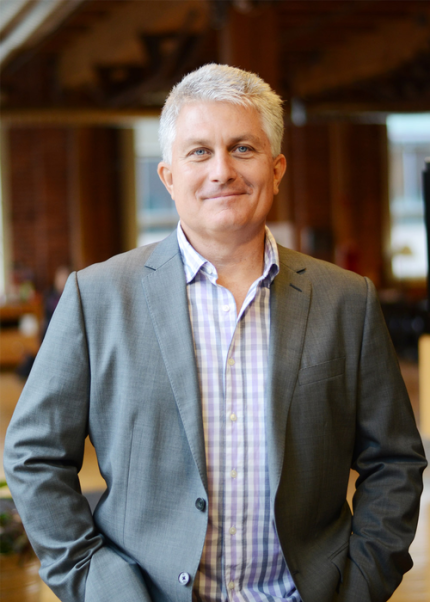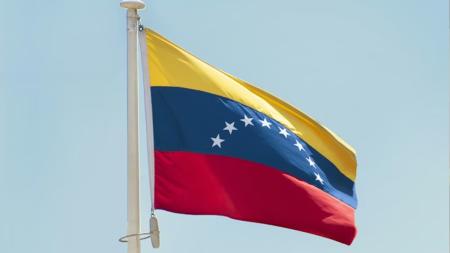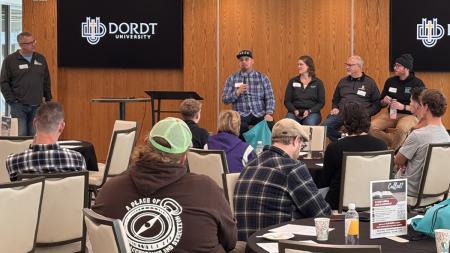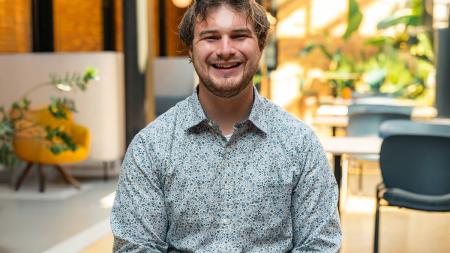January Series Journeys

Craig Detweiler
Calvin College
In four recent January Series 2019 presentations, the speakers — Mariela Shaker, Barbara Pierce Bush, Craig Detweiler, and Leland Melvin — took audiences on journeys ranging from Syria to the United States, from the White House to a school in Italy, from leading a seminary in Seattle to exploring the benefits and downsides of taking selfies, and from playing professional football to flying in space.
Mariela Shaker
Mariela Shaker was on her way to pick up her bachelor’s degree diploma in business administration at the University of Aleppo in Aleppo, Syria, in January 2013 when civil war broke out.
Mortar shells fell around her; she heard fighting nearby; several of her friends were killed. Aleppo, a “beautiful city filled with culture and beauty” was under siege, and today much of the city is in ruins.
An accomplished violinist, she taught music at the time at the the Arabic Institute of Music. Even as fighting went on, she risked her life by going there to teach. “I wanted to keep music alive in that city, to create beauty out of suffering.”
Seeking to become a better musician, Shaker wanted to further her education, and that couldn’t happen in Syria because of the fighting.
“It broke my heart to see what the people of my country were going through,” she said. “But it was that day when I went to collect my diploma that I knew I needed to leave if I wanted to further my studies.”
She eventually accepted a scholarship at Monmouth College in Illinois. As she continued in school, she used her music and told her story — including the account of her harrowing escape from Syria to Lebanon to catch a plane for the U.S. — as a way to draw attention to the ongoing civil war. She also talked about the plight of refugees.
She was named a “Champion of Change” by President Barack Obama and has performed at venues such as the Kennedy Center, Lincoln Center, United Nations, among others, using her music to build bridges, promote peace, and raise awareness about refugees.
“I am an ambassador for my country,” said Shaker. “Many innocent civilians have died in Syria. We need help. We need to hear the song of music again over the guns.”
Barbara Pierce Bush
Barbara Pierce Bush, daughter of former U.S. President George Bush and granddaughter of former President George H. W. Bush, loved to roam the White House, she said, to play there and to gain a deep sense of history from the place.
Always adventurous, she decided to spend her junior year of high school studying in Rome. After applying and being accepted, she told her parents about her plans. They didn’t argue; her father said she’d already done all of the work to get in, so he let her go.
That year in Rome expanded her perspective and likely played a role in encouraging her to travel the world. Among other things, she cofounded the Global Health Corps in 2009 to mobilize young leaders to create access to health care for everyone everywhere.
In her talk, Pierce Bush spoke of the 9/11 attacks and how they rocked her father and his administration. Her father bore up under the strain, however, she said, and she recalls proudly watching him throw out the first pitch as the World Series began that year in Yankee Stadium.
Every morning now, she awakens to a text from her dad, who offers his thoughts on meditation books they read together, even when they are miles apart.
“I’ve had a number of experiences that have strengthened my faith,” she said. “I’ve lived through loss and incredible experiences that make me believe in something bigger.”
Craig Detweiler
Craig Detweiler has recently been named the third president of the Seattle School of Theology and Psychology. As a teacher, author, filmmaker, theologian, and commentator, he has long been interested in technology.
Seeing the interest that his children and others have in taking selfies on their phones, he decided to go on a journey back through history to see how humans have captured images of themselves over the centuries. He used Scripture to help him on this trip.
“I asked, ‘Why do we make images of ourselves?’ and I realized the answers go back to Genesis where [the Bible teaches that] God created us in his own image. We are reflections of a self-imaging God.”
In his research, he learned of mummified bodies in Egypt on which portraits of the deceased were painted; he looked at Greek statues of their heroes and found out these statues had originally been painted to make them appear more lifelike and human. In the 15th century, Venetian glassmakers made the first mirrors in which you could see yourself, and artists by the score began painting portraits of themselves.
Rembrandt was an artist who portrayed himself across a lifetime.
Detweiler came to realize the significance of portraits and of chronicling your life. Although there are many self-serving examples of selfies, this is also a means by which people tell their own stories.
“I ask if social media can become a place of true self-confession,” he said. “Can we look at taking selfies as wanting to be seen as a child of God?”
Leland Melvin
Leland Melvin grew up in Virginia tinkering with the chemistry set his mother gave him and playing football. He eventually played football at college and professionally.
A master’s degree in materials science engineering led him to work in the NASA Langley testing lab and to create optical fiber sensors for aerospace vehicles. When the space shuttle Challenger exploded shortly after takeoff in January 1986 and Melvin learned that a small, defective part caused the death of seven crew members, he wanted to do more to help the U.S. in its venture into space.
Incurring some hearing loss while training to be an astronaut, however, disqualified him from flying into space. But Melvin persevered, and he was eventually welcomed back into the program. As an astronaut, he set off to install a laboratory on the space shuttle Atlantis. After that, he went on a mission to the International Space Station.
Today those journeys remain high points of all his years on earth. “From space, I saw the beautiful oasis of life that we all share as one civilization,” he said.
He saw the twisting and curling Mississippi River and New Orleans, the Andes Mountains, and the sands of Egypt. And once, he said, while flying in the shuttle, they passed over the capitol building in Washington, D.C.
“In space, you realize how insignificant the things that we think significant really are. . . . From space, you see this magnificent creation as being of all one piece.”


